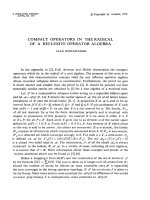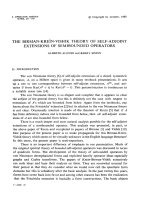Báo cáo toán học: "Exponential triple" pptx
Bạn đang xem bản rút gọn của tài liệu. Xem và tải ngay bản đầy đủ của tài liệu tại đây (118.98 KB, 7 trang )
Exponential triples
Alessandro Sisto
Mathematical Institute, 24-29 St Giles, Oxford OX1 3LB, United Kingdom
Submitted: Mar 6, 2011; Accepted: Jul 6, 2011; Published: Jul 15, 2011
Mathematics Subject Classification: 05A17
Abstract
Using ultrafilter techniques we show that in any p artition of N into 2 cells there
is one cell containing infinitely many exponential triples, i.e. triples of the kind
a, b, a
b
(with a, b > 1). Also, we will show that any multiplicative IP
∗
set is an
“exponential IP set”, the analogue of an IP set with respect to exponentiation.
Introduction
A well-known theorem by Hindman states that given any finite partition of N, there exists
an infinite sets X and one cell of the partition containing the finite sums of X (and also
the finite products of some infinite set Y ), see [Hi]. Ultrafilters can be used to give a
simpler proof than the original one, see [Be]
1
, [HS].
We will be interested in similar results involving exponentiation instead of addition
and multiplication, and our methods of proof will involve ultrafilter arguments. The first
main result of this paper is the following.
Theorem 1. Consi der a partition of the natural numbers N = A ∪ B. Either A or B
contains i nfin i tely many triples a, b, a
b
, with a, b > 1.
Next, we will provide results (Theorems 14 and 15) which allow to find larger structures
than the triples as above inside multiplicative IP
∗
sets (see Definition 12) . A corollary of
those theorems (Corollary 16) is given below.
Definition 2. Consider an infinite set X ⊆ N and write X = {x
i
}
i∈N
, with x
j
< x
j+1
for
each j. Define inductively
F E
I
n+1
(X) = {y
x
n+1
|y ∈ F E
I
n
(X)} ∪ F E
I
n
(X) ∪ {x
n+1
},
F E
II
n+1
(X) = {(x
n+1
)
y
|y ∈ F E
II
n
(X)} ∪ F E
II
n
(X) ∪ {x
n+1
},
1
This is available on Bergelson’s webpa ge />∼
vitaly/
the electronic journal of combinatorics v18 (2011), #P147 1
with F E
I
0
(X) = F E
II
0
(X) = {x
0
}. Set
F E
I
(X) =
n∈N
F E
I
n
(X),
F E
II
(X) =
n∈N
F E
II
n
(X).
We will say that C ⊆ N is an exponential IP set of type I (resp. II) if it contains a set
F E
I
(X) (resp. F E
II
(X)) for some infinite X.
As usual, F S(C) and F P (C) denote the set of finite sums and finite products of C ⊆ N
(see definition 4).
Theorem 3. Given any multiplicative IP
∗
set A there exist some infinite X, Y ⊆ N such
that F S(X), F E
I
(X), F P (Y ), F E
II
(Y ) ⊆ A.
Acknowledgement
The author thanks Mauro Di Nasso for suggesting the problem and the referee for very
helpful recommendations.
1 Preliminaries
This section contains all the results a bout ultrafilters we will need. The reader is referred
to [Be] and [HS] for further details.
An ultrafilter U on N is a collection of subsets o f N such that
1. N ∈ U,
2. A, B ∈ U ⇒ A ∩ B ∈ U,
3. A ∈ U, B ⊇ A ⇒ B ∈ U,
4. ∀A ⊆ N either A ∈ U or A
c
∈ U.
The set of all ultrafilters on N is denoted by βN. Notice that it contains a copy of N:
given any n ∈ N the collection of subsets of N containing n is an ultrafilter. The sum and
product on N can be extended
2
to βN to operations that we will still denote by + and ·
(they are not commutative). We have that (βN, +) and (βN, ·) are semigroups.
Given a semigroup (S, ∗), an idempotent in (S, ∗) is s ∈ S such that s ∗ s = s.
Idempotent ultrafilters are of interest to us because of the result stated below.
2
Indeed, there are two ways to do this, and the one used in [Be] is not the same as the one used in
[HS]. This will not affect what follows.
the electronic journal of combinatorics v18 (2011), #P147 2
Definition 4. Let X be a subset of N. Denote
F S(X) =
n
i=0
x
i
|n ∈ N, x
i
∈ X , x
0
< · · · < x
n
and
F P (X) =
n
i=0
x
i
|n ∈ N, x
i
∈ X , x
0
< · · · < x
n
.
We will say that C ⊆ N is an additive (resp. multiplicative) IP set if it contains a set
F S(X) (resp. F P (X)) for some infinite X.
Theorem 5 ([HS], Theorem 5.8, Lemma 5.11). (βN, +) and (βN, ·) contain idem potent
ultrafilters. Also, if U is idempotent in (βN, +) (resp. (βN, ·)) then any U ∈ U is an
additive (resp. multiplicative) IP set. What is more, given any sequence {x
n
}
n∈N
there
exists an ultrafilter idempotent in (βN, +) (resp. (βN, ·)) such that for each m ∈ N,
F S({x
n
}
n≥m
) ∈ U (resp. F P ({x
n
}
n≥m
) ∈ U).
We will also need the following.
Theorem 6. There exists U ∈ βN such that each U ∈ U contains a rb i trarily long (non-
trivial) geometric progressions.
Proof. The theorem follows from [HS, Theorem 5.7] together with (a corollary of) van
der Waerden’s Theorem that given any finite partition of N t here is one cell containing
arbitrarily long g eometric progressions. (The usual van der Waerden’s Theorem gives a
cell containing arbitrarily long arithmetic progressions, but one can deduce the stated
result considering the restriction of the partition to {2
n
: n ∈ N}.)
(The theorem can also be proven considering minimal idempotent ultrafilters.)
We will use the following notation.
Definition 7. If A ⊆ N and n ∈ N denote
1. −n + A = {m ∈ N : m + n ∈ A},
2. if n ≥ 1, (n
−1
)A = {m ∈ N : m · n ∈ A},
3. if n ≥ 2, log
n
[A] = {m ∈ N : n
m
∈ A},
4. if n ≥ 1, A
1/n
= {m ∈ N : m
n
∈ A}.
Definition 8. Fix a n ultrafilter U on N and let A ⊆ N. Set
A
⋆
+
= {x ∈ A : −x + A ∈ U},
A
⋆
•
= {x ∈ A : (x
−1
)A ∈ U}.
Lemma 9 ([HS], Lemma 4.14). If U + U = U (resp. U · U = U) and A ∈ U, then A
⋆
+
∈ U
(resp. A
⋆
•
∈ U).
the electronic journal of combinatorics v18 (2011), #P147 3
2 Exponential triples and exponential IP s ets
2.1 Exponential triples
Definition 10. An exponential triple is an ordered triple of natural numbers (a, b, c)
such that a
b
= c and a, b > 1, to avoid trivialities. We will say that C ⊆ N contains the
exponential tr iple (a, b, c) if a, b, c ∈ C.
Theorem 11. Consider a partition of the natural numbers N = A ∪ B. Either A or B
contains i nfin i tely many exponential triples.
Proof. Let U be an ultrafilter as in Theorem 6. Up to exchanging A and B, we can
assume A ∈ U. Set, f or each n ≥ 2 , A
n
= log
n
[A] ∩ A and B
n
= log
n
[B] ∩ A. If A
n
∈ U
for each n > 1, then clearly A contains infinitely many exponential triples (if a ∈ A and
b ∈ A ∩ log
a
[A] then {a, b, a
b
} ⊆ A).
If this is not the ca se, consider some n > 1 such that B
n
∈ U. Consider a geometric
progression a, ah, . . . , ah
k
contained in B
n
(with a > 0, h > 1). If h
i
∈ B for some
i ∈ {1, . . . , k}, we have that the exponential triple (n
a
, h
i
, n
ah
i
) is contained in B. If there
are infinitely many geometric progressions a, ah, . . . , ah
k
(a > 0, h > 1) contained in B
n
and such that h
i
∈ B for some i ∈ {1, . . . , k}, by the argument above it is readily seen
that B contains infinitely many exponential triples.
Finally, if this does not hold we have that A contains arbitrarily long progressions of
the kind h, h
2
, . . . , h
k
. It is clear in this case that A contains infinitely many exponential
triples.
2.2 Exponential IP sets
Definition 12. An additive (resp. multiplicative) IP
∗
set is a set whose complement is
not an additive (resp. multiplicative) IP set.
Lemma 13. Let A be a m ultiplicative IP
∗
set and let n ∈ N.
1. If n ≥ 2 then log
n
[A] is an additive IP
∗
set.
2. If n ≥ 1, A
1/n
is a multiplicative IP
∗
set.
Proof. 1) Consider F S(X) for some infinite X. We have to show log
n
[A] ∩ F S(X) =
∅. As A is a multiplicative IP
∗
set we have F P (n
X
) ∩ A = ∅, which clearly implies
log
n
[A] ∩ F S( X) = ∅.
2) Consider FP(X) for some infinite X. As F P (X
n
)∩A = ∅, we have A
1/n
∩F P (X) =
∅.
The following theorem is inspired by [HS, Theorem 16.20], and the proof closely follows
the proof of that theorem. (A simpler proof of a simpler fact will be given in Remark 17.)
We will denote the collection of finite subsets of N by P
f
(N).
the electronic journal of combinatorics v18 (2011), #P147 4
Theorem 14. Let S be the set of finite sequences in N (including the empty sequence) and
let f : S → N. Let {y
n
}
n∈N
⊆ N be a sequence and let A be a multiplicative IP
∗
set. Then
there exists {x
n
}
n∈N
such that F S({x
n
}
n∈N
) ⊆ F S({y
n
}
n∈N
) and whenever F ∈ P
f
(N),
l = f((x
0
, . . . , x
min F−1
)) and t ∈ {2, . . . , l} we have t
P
j∈F
x
j
∈ A.
Proof. In this proof we set C
⋆
= C
⋆
+
for each C ⊆ N. Let U be an ultrafilter idempotent
in (βN, +) such that F S({y
n
}
n≥m
) ∈ U for each m ∈ N; see Theorem 5. By the previous
lemma, for each t ∈ N with t ≥ 2 we have that log
t
[A] is an additive IP
∗
set, and therefore
log
t
[A] ∈ U. In particular, we have B
0
∈ U, where
B
0
= F S({y
n
}
n∈N
) ∩
f(∅)
t=2
log
t
[A].
Pick a ny x
0
∈ B
⋆
0
and H
0
∈ P
f
(N) such that x
0
=
t∈H
0
y
t
.
We will choose inductively x
i
, H
i
and B
i
satisfying the following properties.
1. x
i
=
t∈H
i
y
t
,
2. if i ≥ 1 then min H
i
> max H
i−1
,
3. B
i
∈ U,
4. for each ∅ = F ⊆ {0, . . . , i} a nd m = min F we have
j∈F
x
j
∈ B
⋆
m
,
5. if i ≥ 1, then B
i
⊆
f((x
0
, ,x
i−1
))
t=2
log
t
[A].
Those properties are satisfied for x
0
, H
0
, B
0
chosen as above. Let us now perform
the inductive step: suppose that we have x
i
, H
i
and B
i
for i ≤ n satisfying the required
proper ties.
Set k = max H
n
+ 1. By our choice of U, we have F S({y
t
}
t≥k
) ∈ U. Set, for m ≤ n,
E
m
=
j∈F
x
j
: ∅ = F ⊆ {0, . . . , n} and m = min F
.
By ( 4), E
m
⊆ B
⋆
m
for each m ≤ n, so that for every a ∈ E
m
we have −a + B
⋆
m
∈ U by
Lemma 13. We can then set
B
n+1
= F S({y
t
}
t≥k
) ∩
f((x
0
, ,x
n
))
t=2
log
t
[A] ∩
m≤n
a∈E
m
(−a + B
⋆
m
),
and we have B
n+1
∈ U. Pick any x
n+1
∈ B
⋆
n+1
and choose H
n+1
∈ P
f
(N) with min H
n+1
≥
k a nd x
n+1
=
t∈H
n+1
y
t
.
We only need to check (4).
Let ∅ = F ⊆ {0, . . . , n + 1} and set m = min F . We have to show that
j∈F
x
j
∈ B
⋆
m
.
If n + 1 /∈ F, the conclusion holds by the inductive hypothesis. Also, if F = {n + 1}
the electronic journal of combinatorics v18 (2011), #P147 5
then m = n + 1 and
j∈F
x
j
= x
n+1
∈ B
⋆
n+1
= B
⋆
m
. So, we can assume n + 1 ∈ F and
G = F\{n + 1} = ∅. Set a =
j∈G
x
j
. As G is non-empty, we have a ∈ E
m
. Hence (as
B
n+1
⊆ −a + B
⋆
m
) x
n+1
∈ −a + B
⋆
m
, that is to say
j∈F
x
j
= a + x
n+1
∈ B
⋆
m
.
We are now ready to complete the proof. Let F, l, t be as in the st atement . By (4)
and (5) we get
j∈F
x
j
∈ B
min F
⊆ log
t
[A], which by definition means t
P
j∈F
x
j
∈ A. Also,
(1) and (2) guarantee that F S({x
n
}) ⊆ F S({y
n
}).
The following theorem can be proven in the same way, using a suitable ultrafilter
idempo tent in (N, ·) and C
⋆
•
instead of C
⋆
+
.
Theorem 15. Let S be the set of finite sequences in N and let f : S → N. Let {y
n
}
n∈N
⊆
N be a sequence and let A be a multiplicative IP
∗
set. Then there exists {x
n
}
n∈N
such
that FP({x
n
}
n∈N
) ⊆ F P ({y
n
}
n∈N
) and whenever F ∈ P
f
(N), l = f((x
0
, . . . , x
min F−1
))
and t ∈ {1, . . . , l} we have (
j∈F
x
j
)
t
∈ A.
We now give an application of the theorems above. One can define similar notions of
exponential IP set and obtain the corollary below using the same argument. Recall that
we defined exponential IP sets in the Introduction.
Corollary 16. For any multiplicative IP
∗
set A there exists some infinite X, Y ⊆ N such
that F S(X), F E
I
(X), F P (Y ), F E
II
(Y ) ⊆ A.
Proof. Let B = A
c
. The main result of [Hi] ([HS, Corollary 5.22]) gives that one between
A and B is both an additive and a multiplicative IP set. But B is not a multiplicative
IP set, hence A is an additive IP set. Let {y
i
} be such that F S({y
i
}
i∈N
) ⊆ A, and
define f : S → N as f((x
0
, . . . , x
n
)) = max F E
I
n
({x
0
, . . . , x
n
}). Let X = {x
n
}
n∈N
be as
in Theorem 14 (we can assume that each x
i
is greater than 1). Clearly, F S(X) ⊆ A. We
will show inductively FE
I
i
(X) ⊆ A. Notice that X ⊆ A (in particular F E
I
0
(X) ⊆ A).
Suppose F E
I
n
(X) ⊆ A and consider y
x
n+1
∈ F E
I
n+1
(X). As 2 ≤ y ≤ f((x
0
, . . . , x
n
)),
Theorem 14 gives y
x
n+1
∈ A.
The set Y can be found applying Theorem 15 in a similar way.
Remark 17. We now give a simpler proof that any multiplicative IP
∗
set is an exponen-
tial IP set of type I (a similar proof can be given for type II).
Let A be a multiplicative IP
∗
set and let B = A
c
. As shown in the proof of the
corollary, A is an additive IP set. Let U be an idempotent ultrafilter in (βN, +) such
that A ∈ U (see Theorem 5).
For each n ∈ N, n > 1, we have that B
n
= lo g
n
[B] ∩ A /∈ U, for otherwise B
n
would be an additive IP set and n
B
n
⊆ B would be a multiplicative IP set. Therefore
A
n
= log
n
[A] ∩ A ∈ U, for each n > 1. We are ready to construct a set X such that
F E
I
(X) ⊆ A. Just set X = {x
i
}
i∈N
, for any sequence {x
i
} which satisfies:
x
0
∈ A, x
0
> 1,
N
i
= max F E
I
i
({x
j
}
j≤i
),
x
i+1
∈
N
i
j=2
A
j
∩ A.
the electronic journal of combinatorics v18 (2011), #P147 6
2.3 Open questions
There are several natural questions which arise at this point. For example, is there an
elementary proof of Theorem 11? Does it hold for partitions of N into finitely many cells?
How about just 3 cells? Is it true that given any partition of N into 2 cells, one of the
cells is an exp onential IP set (of type I and/or II)? How about finitely many cells?
References
[Be] V. Bergelson - Combinatorial and Diophantine appli cations of ergodic theory, Hand-
book of dynamical systems. Vol. 1B, 745-869 , Elsevier B. V., Amsterdam, 2006.
[Hi] N. Hindman - Partitions and sums and products of integers, Trans. Amer. Math.
Soc. 247 (1979), 227-24 5.
[HS] N. Hindman, D. Strauss - Algebra in the Stone-
ˇ
Cech compactification. Theory an d
applications, de Gruyter, Berlin, 1998.
the electronic journal of combinatorics v18 (2011), #P147 7









